1990 VOLKSWAGEN TRANSPORTER load capacity
[x] Cancel search: load capacityPage 43 of 165
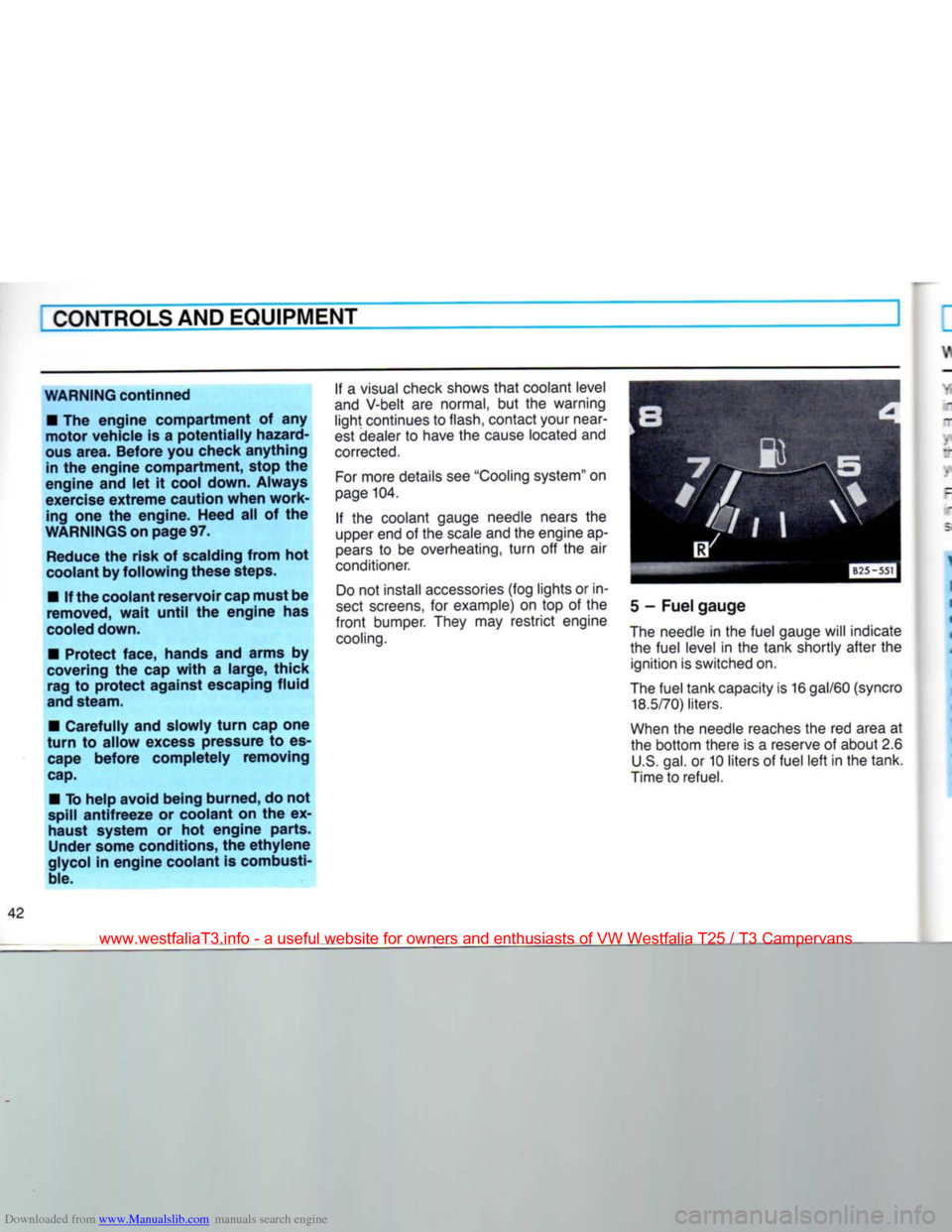
Downloaded from www.Manualslib.com manuals search engine
CONTROLS
AND
EQUIPMENT
WARNING continned •
The
engine compartment
of any
motor vehicle
is a
potentially hazard
ous
area.
Before you check anything in the engine compartment, stop
the
engine and
let it
cool down. Always
exercise extreme caution when work
ing
one the
engine. Heed
all of the
WARNINGS on page
97.
Reduce the risk
of
scalding from
hot
coolant by following these steps.
• If the coolant reservoir cap must be
removed, wait until
the
engine
has
cooled down.
• Protect face, hands
and
arms
by
covering
the cap
with
a
large, thick
rag
to
protect against escaping fluid
and
steam.
• Carefully and slowly
turn
cap
one
turn
to
allow excess pressure
to es
cape before completely removing
cap.
•
To
help avoid being burned,
do not
spill
antifreeze
or
coolant
on the ex
haust system
or hot
engine parts.
Under
some conditions, the ethylene
glycol
in
engine coolant
is
combusti
ble.
If a
visual check shows that coolant level
and V-belt
are
normal,
but the
warning light continues to
flash,
contact
your
near
est dealer
to
have
the
cause located
and
corrected.
For more details see "Cooling system"
on
page 104.
If the
coolant gauge needle nears
the
upper end
of
the scale and the engine ap
pears
to be
overheating,
turn
off the air
conditioner.
Do
not
install accessories
(fog
lights
or
in
sect screens,
for
example)
on top of the
front
bumper.
They
may
restrict engine
cooling.
5
-
Fuel gauge
The needle
in
the fuel gauge will indicate the fuel level
in the
tank shortly after
the
ignition is switched on.
The fuel tank capacity is
16
gal/60
(syncro
18.5/70)
liters.
When
the
needle reaches the
red
area
at
the bottom there
is a
reserve
of
about 2.6 U.S. gal.
or
10 liters
of
fuel left in the tank.
Time to refuel.
www.westfaliaT3.info - a useful website for owners and enthusiasts of VW Westfalia T25 / T3 Campervans
Page 57 of 165
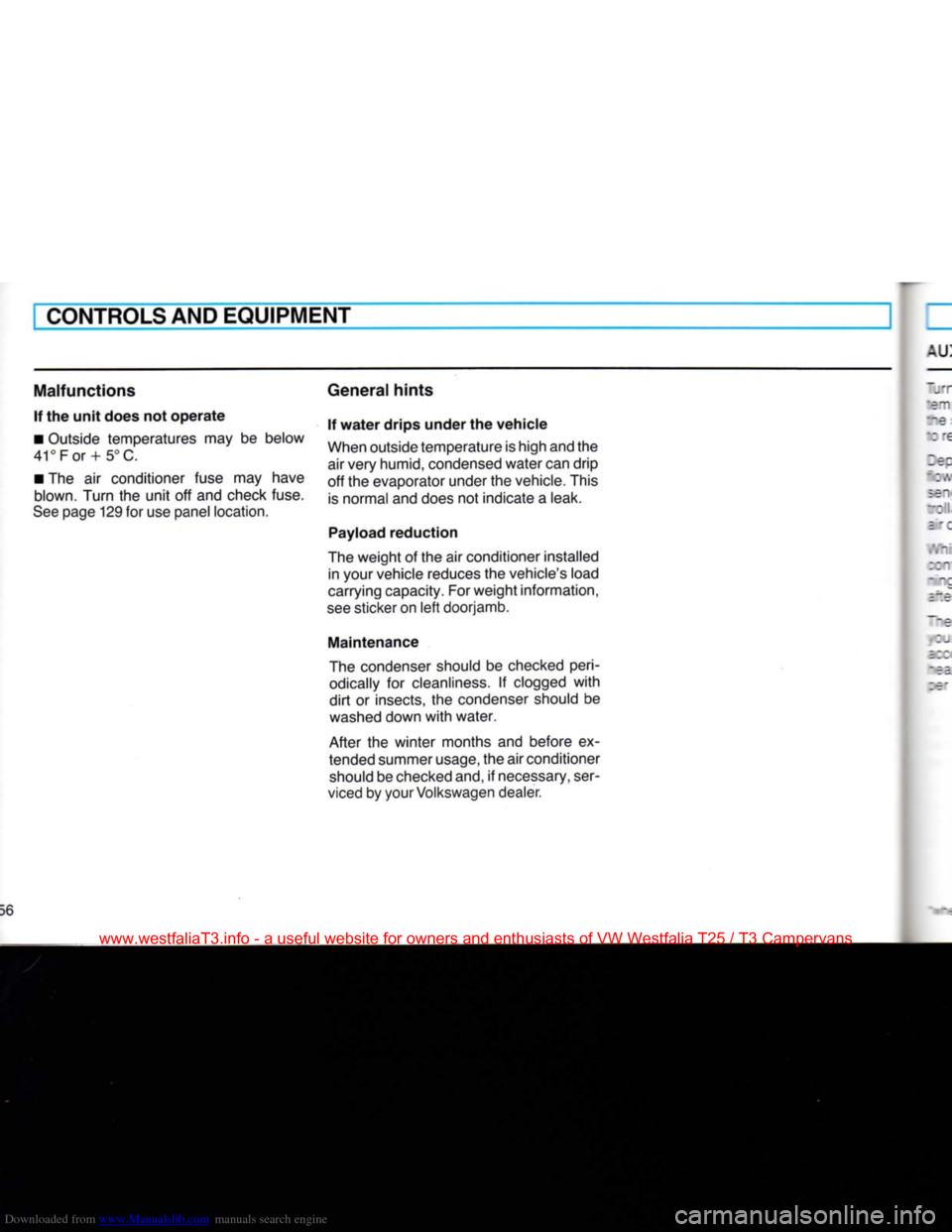
Downloaded from www.Manualslib.com manuals search engine
CONTROLS AND
EQUIPMENT
Malfunctions
if the
unit
does not
operate
• Outside temperatures may be below
41° For + 5°C.
• The air conditioner fuse may have blown. Turn the
unit
off and check fuse.
See
page 129 for use panel location.
General
hints
If
water
drips
under
the
vehicle
When outside temperature is high and the
air very humid, condensed water can drip
off the evaporator under the vehicle. This
is
normal and does not indicate a leak.
Payload
reduction
The weight of the air conditioner installed in your vehicle reduces the vehicle's load
carrying capacity. For weight information,
see
sticker on
left
doorjamb.
Maintenance
The condenser should be checked peri
odically for cleanliness. If clogged
with
dirt
or insects, the condenser should be
washed down
with
water.
After the winter months and before ex
tended summer
usage,
the air conditioner should be checked and, if necessary, ser
viced by your Volkswagen dealer.
www.westfaliaT3.info - a useful website for owners and enthusiasts of VW Westfalia T25 / T3 Campervans
Page 59 of 165
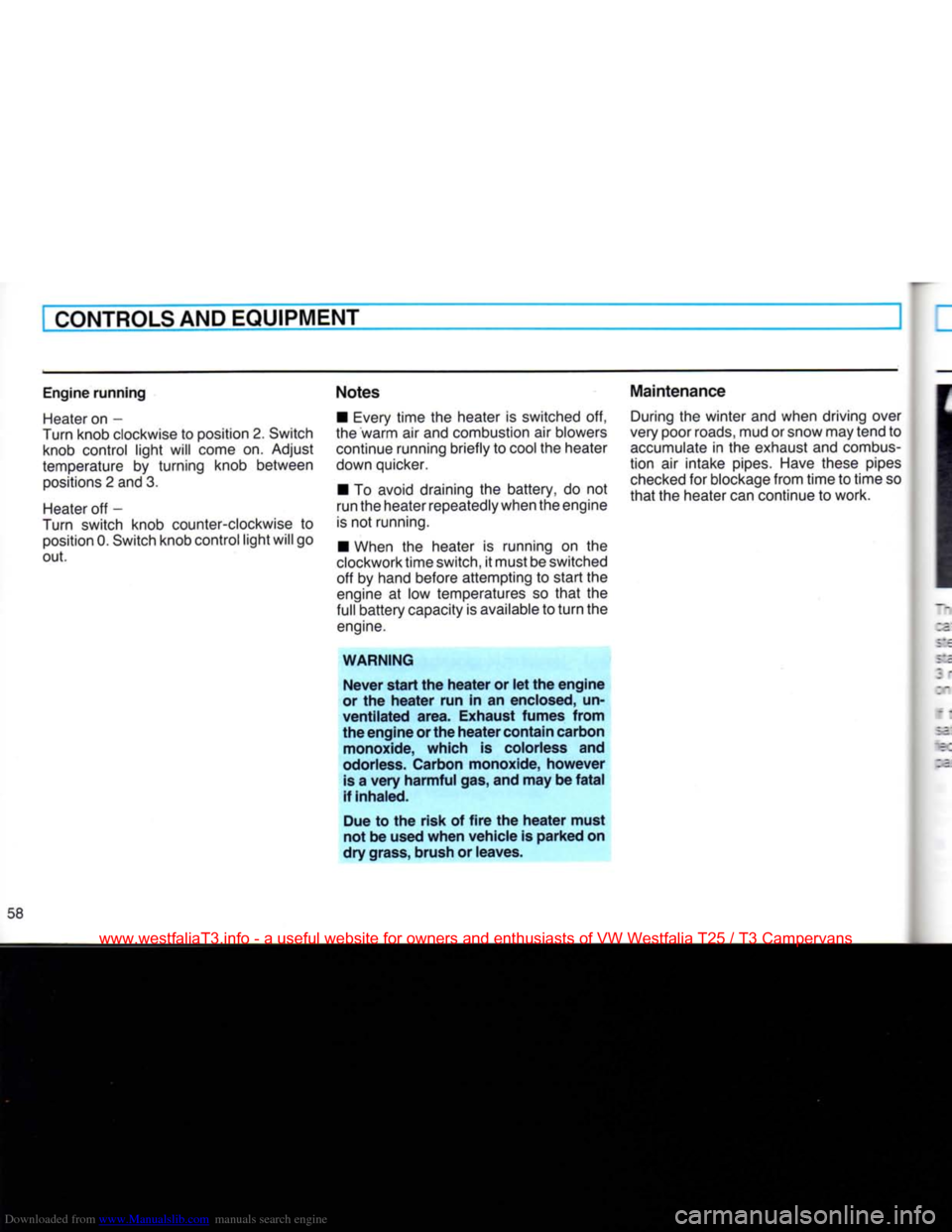
Downloaded from www.Manualslib.com manuals search engine
CONTROLS AND EQUIPMENT
Engine
running
Heater
on -
Turn knob clockwise to position 2. Switch knob control light will come on. Adjust
temperature by turning knob between positions 2 and 3.
Heater
off -
Turn switch knob counter-clockwise to position 0. Switch knob control light will go
out.
Notes
• Every time the heater is switched off,
the warm air and combustion air blowers continue running briefly to cool the heater
down quicker.
• To avoid draining the battery, do not
run the heater repeatedly when the engine
is
not running.
• When the heater is running on the
clockwork time switch, it must be switched
off by hand before attempting to start the
engine at low temperatures so
that
the
full
battery capacity is available to
turn
the
engine.
WARNING
Never
start
the
heater
or let the
engine
or the
heater
run in an enclosed, un-
ventilated
area.
Exhaust
fumes
from
the
engine
or the
heater
contain
carbon monoxide,
which
is colorless and
odorless. Carbon monoxide,
however
is a
very
harmful
gas, and may be
fatal
if inhaled.
Due to the
risk
of
fire
the
heater
must
not be used
when
vehicle
is
parked
on
dry grass, brush or leaves.
Maintenance
During the winter and when driving over
very poor roads, mud or snow may tend to
accumulate
in the exhaust and combus
tion air intake pipes. Have these pipes
checked
for blockage from time to time so
that
the heater can continue to work.
58
www.westfaliaT3.info - a useful website for owners and enthusiasts of VW Westfalia T25 / T3 Campervans
Page 69 of 165
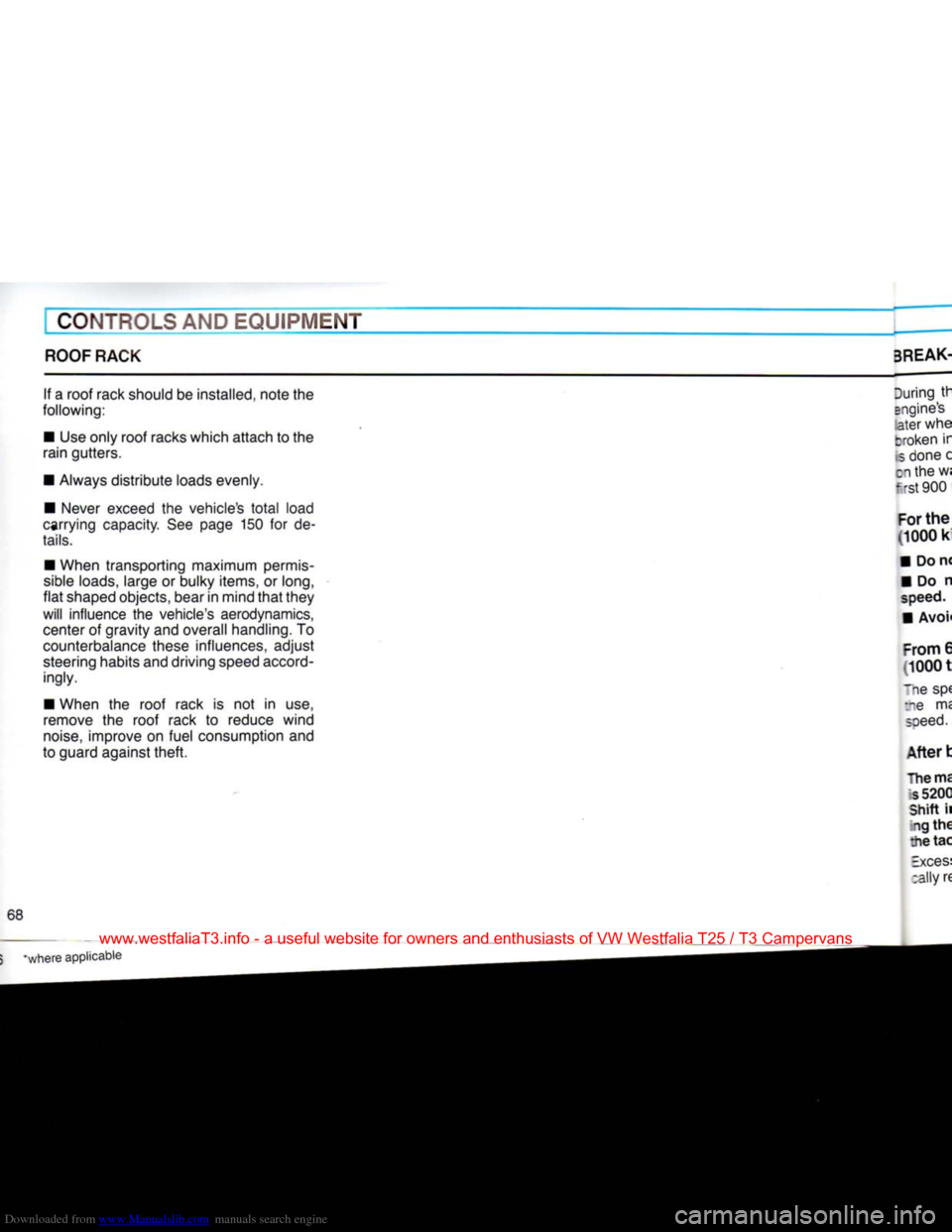
Downloaded from www.Manualslib.com manuals search engine
CONTROLS
AND
EQUIPMENT
ROOF RACK 3REAK-
If a roof rack should be installed, note the
following:
• Use only roof racks which attach to the
rain gutters.
• Always distribute loads evenly.
• Never exceed the vehicle's
total
load
carrying capacity. See page 150 for de
tails.
• When transporting maximum permis
sible
loads, large or bulky items, or long,
flat
shaped objects, bear in mind
that
they
will
influence the vehicle's aerodynamics,
center of gravity and overall handling. To
counterbalance these influences, adjust steering habits and driving speed accord
ingly.
• When the roof rack is not in use,
remove the roof rack to reduce wind
noise,
improve on fuel consumption and
to guard against
theft.
68
www.westfaliaT3.info - a useful website for owners and enthusiasts of VW Westfalia T25 / T3 Campervans
Page 90 of 165
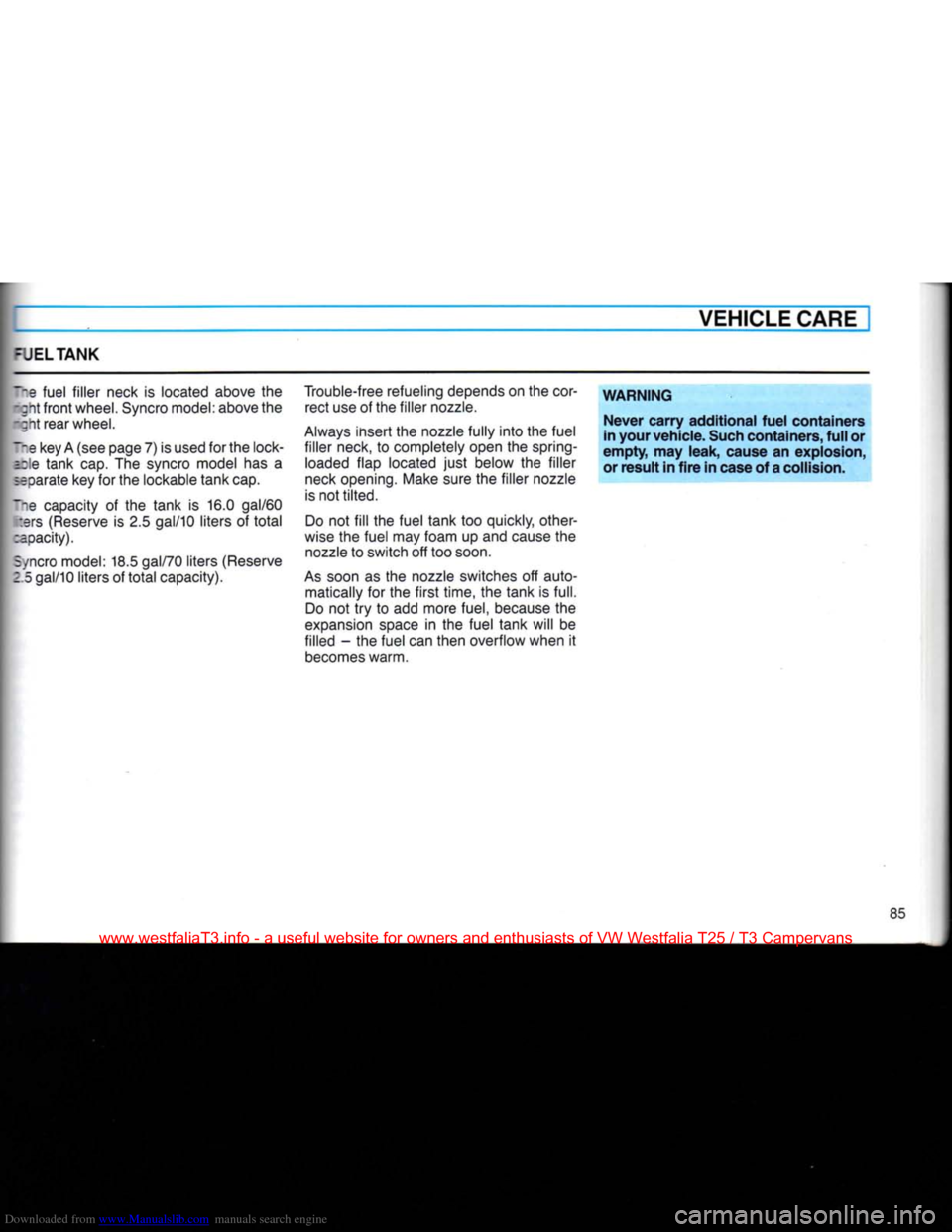
Downloaded from www.Manualslib.com manuals search engine
VEHICLE CARE
=UELTANK
|he fuel filler neck is located above the -gnt
front
wheel. Syncro model: above the
-;nt rear wheel.
mm key A (see page 7) is used for the lock-
acle
tank cap. The syncro model has a separate key for the lockable tank cap.
capacity of the tank is 16.0 gal/60
:ers
(Reserve is 2.5 gal/10 liters of
total
rapacity).
5/ncro model: 18.5 gal/70 liters (Reserve
2
5 gal/10 liters of
total
capacity). Trouble-free refueling depends on the cor
rect use of the filler nozzle.
Always
insert the nozzle fully
into
the fuel filler neck, to completely open the spring-loaded flap located
just
below the filler
neck opening. Make sure the filler nozzle
is
not tilted.
Do
not
fill
the fuel tank too quickly, other
wise the fuel may foam up and cause the
nozzle
to switch off too
soon.
As
soon as the nozzle switches off auto matically for the
first
time, the tank is full.
Do
not try to add more fuel, because the
expansion
space in the fuel tank will be
filled - the fuel can then overflow when it
becomes
warm.
WARNING
Never
carry
additional
fuel
containers
in
your
vehicle.
Such
containers,
full
or
empty,
may
leak,
cause an explosion,
or
result
in
fire
in case of a collision.
85
www.westfaliaT3.info - a useful website for owners and enthusiasts of VW Westfalia T25 / T3 Campervans
Page 105 of 165
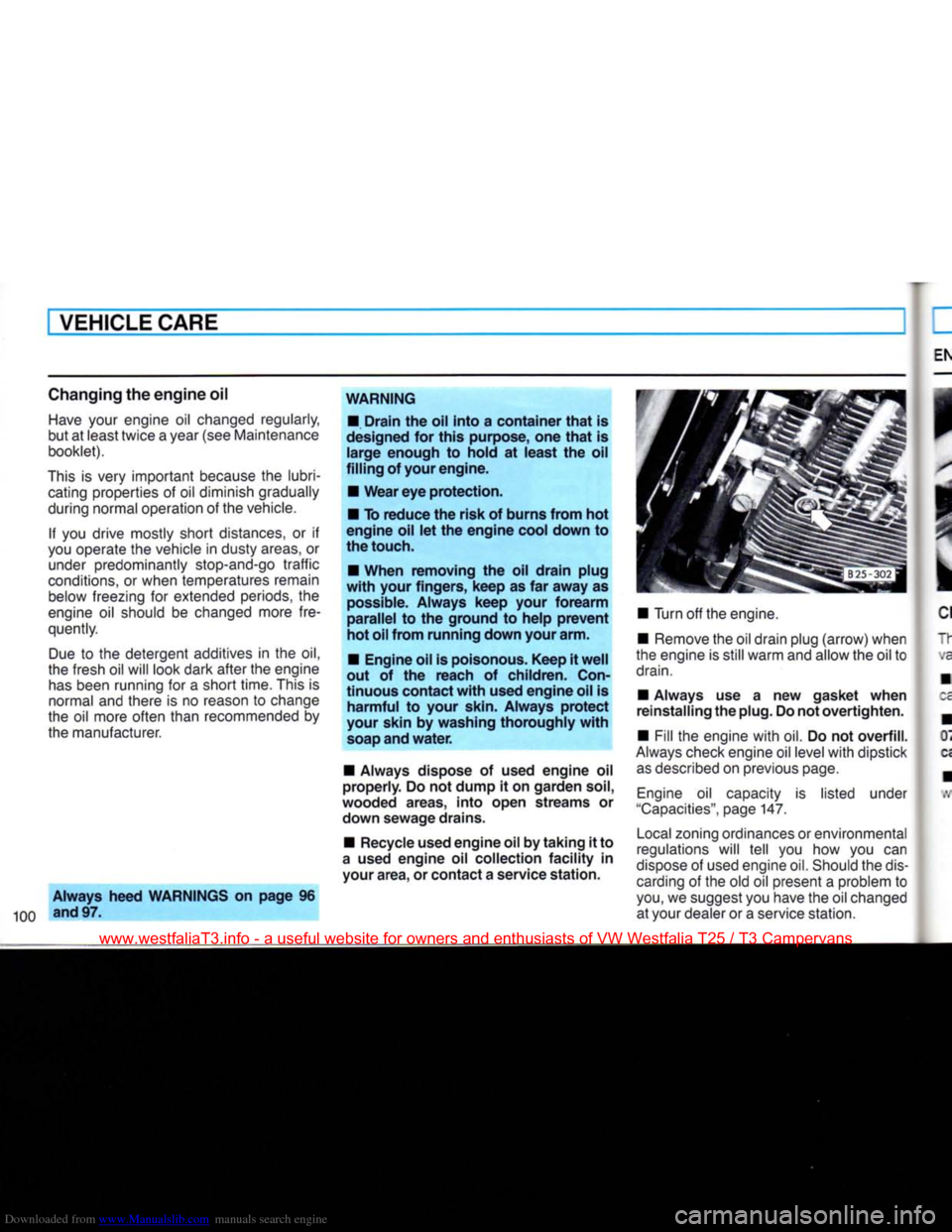
Downloaded from www.Manualslib.com manuals search engine
VEHICLE CARE
Changing the
engine
oil
Have
your engine oil changed regularly,
but at least twice a year (see Maintenance
booklet).
This
is very important because the lubri cating properties of oil diminish gradually
during normal operation of the vehicle.
If you drive mostly short distances, or if
you operate the vehicle in dusty
areas,
or under predominantly stop-and-go traffic
conditions, or when temperatures remain below freezing for extended periods, the
engine oil should be changed more fre
quently.
Due
to the detergent additives in the oil,
the fresh oil will look dark after the engine
has
been running for a short time. This is
normal and there is no reason to change
the oil more often than recommended by
the manufacturer.
Always
heed
WARNINGS
on
page
96
100 and97-
WARNING
•
Drain
the oil
into
a
container
that
is
designed for
this
purpose, one
that
is
large
enough to hold at
least
the oil
filling
of your
engine.
•
Wear
eye
protection.
• To
reduce
the
risk
of burns
from
hot
engine
oil let the
engine
cool
down
to
the touch.
•
When
removing
the oil
drain
plug
with
your fingers,
keep
as far
away
as possible.
Always
keep
your
forearm
parallel
to the ground to
help
prevent
hot oil
from
running
down
your arm.
• Engine oil is poisonous. Keep it
well
out of the
reach
of children. Con
tinuous
contact
with
used
engine
oil is
harmful
to your skin.
Always
protect
your skin by
washing
thoroughly
with
soap and
water.
•
Always
dispose of used
engine
oil
properly.
Do not
dump
it on
garden
soil,
wooded
areas,
into
open
streams
or
down
sewage
drains.
• Recycle used
engine
oil by
taking
it to
a used
engine
oil collection
facility
in
your
area,
or
contact
a service
station.
• Turn off the engine.
• Remove the oil drain plug (arrow) when
the engine is still warm and allow the oil to
drain.
•
Always
use a new
gasket
when
reinstalling
the plug. Do not
overtighten.
•
Fill
the engine
with
oil. Do not
overfill.
Always
check engine oil level
with
dipstick
as
described on previous page.
Engine
oil capacity is listed under
"Capacities",
page 147.
Local
zoning ordinances or environmental
regulations will tell you how you can
dispose
of used engine oil. Should the dis carding of the old oil present a problem to
you,
we suggest you have the oil changed
at your dealer or a service station.
www.westfaliaT3.info - a useful website for owners and enthusiasts of VW Westfalia T25 / T3 Campervans
Page 115 of 165
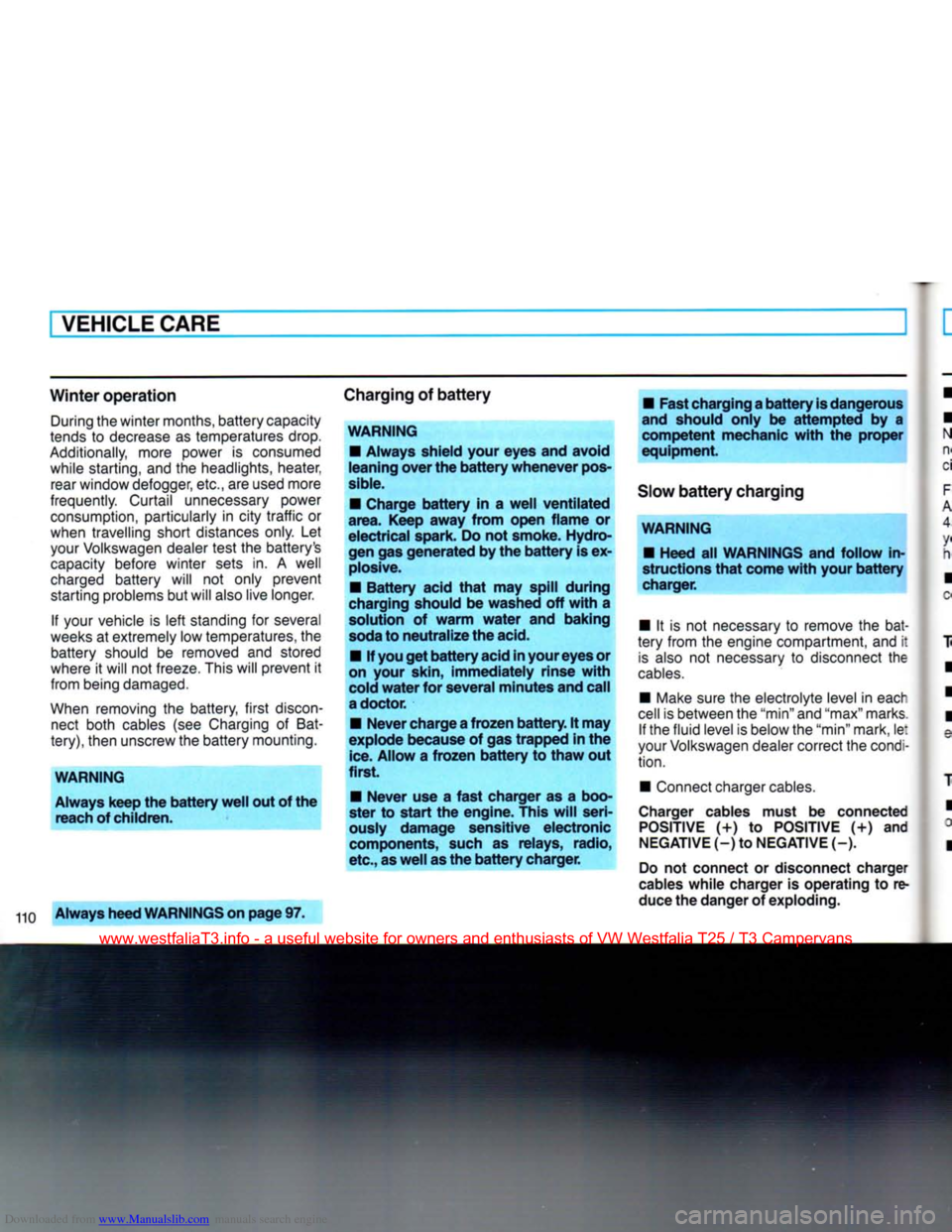
Downloaded from www.Manualslib.com manuals search engine
VEHICLE
CARE
Winter operation During the winter months, battery capacity
tends to decrease as temperatures drop.
Additionally, more power is consumed while starting, and the headlights, heater, rear window defogger, etc., are used more
frequently. Curtail unnecessary power
consumption,
particularly in city traffic or
when travelling short distances only. Let
your
Volkswagen dealer test the battery's
capacity before winter sets in. A well
charged battery will not only prevent
starting
problems but will also live longer.
If
your
vehicle is left standing for several
weeks
at extremely low temperatures, the battery should be removed and stored
where it will not freeze.
This
will prevent it
from being damaged.
When removing the battery, first discon nect both cables (see Charging of Bat
tery),
then unscrew the battery mounting.
WARNING
Always keep the battery well out of the reach of children.
Always heed WARNINGS on page
97.
Charging of battery
WARNING
•
Always shield
your
eyes and avoid
leaning
over
the battery whenever pos
sible.
•
Charge battery in a well ventilated
area.
Keep away from open flame or
electrical
spark. Do not
smoke.
Hydro gen gas generated by the battery is explosive.
•
Battery acid that may spill during
charging should be washed off with a solution of warm water and baking
soda
to neutralize the
acid.
•
If you get battery
acid
in
your
eyes or
on
your
skin,
immediately rinse with
cold
water for several minutes and
call
a
doctor.
•
Never charge
a
frozen battery. It may
explode because of gas trapped in the
ice.
Allow a frozen battery to thaw out
first.
•
Never use a fast charger as a boo
ster to start the engine.
This
will
seri
ously damage sensitive electronic
components,
such as relays, radio,
etc.,
as well as the battery charger.
•
Fast charging
a
battery
is
dangerous
and should only be attempted by a
competent mechanic with the proper
equipment.
Slow battery charging WARNING
•
Heed all WARNINGS and follow in
structions that come with
your
battery
•
It is not necessary to remove the bat
tery
from the engine compartment, and it
is
also not necessary to disconnect the
cables.
•
Make sure the electrolyte level in each
cell
is between the "min" and "max" marks. If the fluid level is below the "min" mark, le:
your
Volkswagen dealer correct the condi
tion.
•
Connect charger cables.
Charger cables must be connected
POSITIVE
(+) to
POSITIVE
(+) and
NEGATIVE
(-) to
NEGATIVE
(-).
Do not connect or disconnect charger
cables
while charger is operating to re
duce the danger of exploding.
www.westfaliaT3.info - a useful website for owners and enthusiasts of VW Westfalia T25 / T3 Campervans
Page 116 of 165
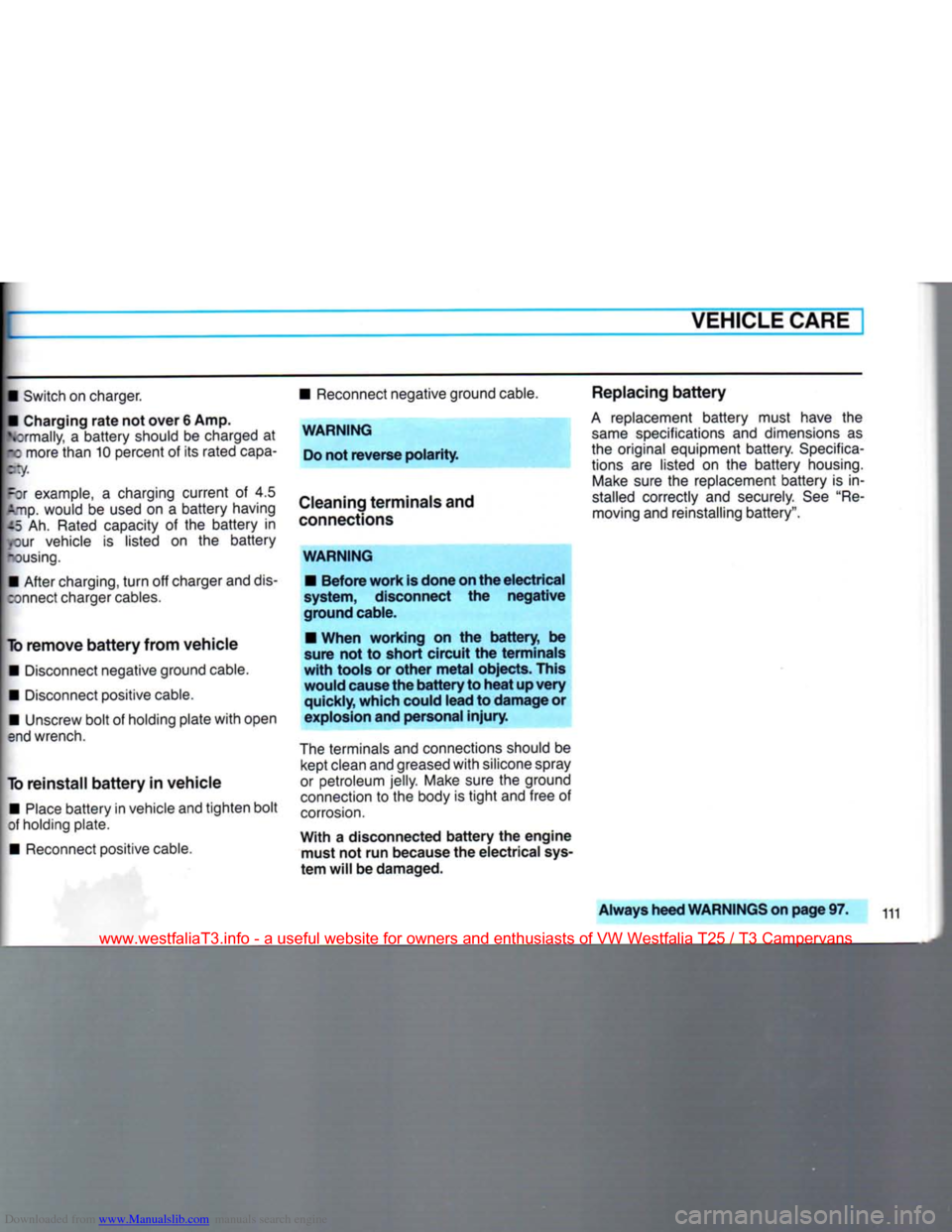
Downloaded from www.Manualslib.com manuals search engine VEHICLE CARE
• Switch on charger.
• Charging
rate
not over 6 Amp.
Vormally,
a battery should be charged at
rc more than 10 percent of its rated
capa
city.
For
example, a charging current of 4.5
Amp.
would be used on a battery having
• Ah. Rated capacity of the battery in .our vehicle is listed on the battery
"Dusing.
• After charging,
turn
off charger and dis-
ronnect charger
cables.
To
remove
battery
from
vehicle • Disconnect negative ground cable.
• Disconnect positive cable.
• Unscrew bolt of holding plate with open
end
wrench.
To
reinstall
battery
in vehicle •
Place
battery in vehicle and tighten bolt
of holding plate.
• Reconnect positive cable. • Reconnect negative ground cable.
WARNING
Do not
reverse
polarity.
Cleaning
terminals
and
connections
WARNING
• Before
work
is done on the
electrical
system, disconnect the
negative
ground cable.
•
When
working
on the
battery,
be
sure not to short circuit the
terminals
with
tools or
other
metal
objects. This
would
cause the
battery
to
heat
up
very
quickly,
which
could
lead
to
damage
or
explosion and personal
injury.
The
terminals and connections should be kept clean and greased with silicone spray
or
petroleum jelly. Make sure the ground
connection
to the body is
tight
and free of
corrosion.
With
a disconnected
battery
the
engine
must
not run because the
electrical
sys
tem
will
be damaged. Replacing
battery
A
replacement battery must have the
same
specifications and dimensions as
the original equipment battery.
Specifica
tions are listed on the battery housing.
Make
sure the replacement battery is in
stalled
correctly and securely. See "Re moving and reinstalling battery".
Always heed
WARNINGS
on
page
97.
www.westfaliaT3.info - a useful website for owners and enthusiasts of VW Westfalia T25 / T3 Campervans